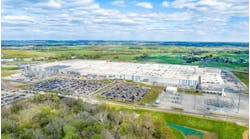The idea of "green" supply chains is taking a backseat to "staying in the black" supply chains, at least in the current economic malaise. Based on the results of a recent survey conducted by consulting firm Accenture, a mere 10% of companies are actively modeling their supply chain carbon footprints and have implemented successful sustainability initiatives.
Best-in-class supply chains -- which Accenture describes as supply chain masters, meaning they've achieved top-quartile performance in both cost effectiveness and customer service -- are much more likely to model their carbon footprints and pursue sustainability projects than other supply chains (20% versus 9%).
"Supply chain masters are making great strides in linking cost effectiveness, customer service and sustainable supply chain practices," says Jonathan Wright, senior executive in Accenture's Supply Chain Management practice. "Despite today's reduced energy costs, there continues to be a business case for greening the supply chain, resulting in lower costs as well as environmentally responsible processes."
The study, based on a survey of nearly 250 global supply chain executives, indicates that 37% of respondents have no idea of the level of supply chain emissions in their supply chain network. On a more positive note, 86% have at least paid lip service to the green movement in their warehouses, generally in the areas of recycling and using natural light, lighting management systems and energy-efficient bulbs. Meanwhile, 38% have undertaken at least one green initiative in their transport fleet, in such areas as streamlining vehicle design, adopting green fuels and vehicles with hybrid engines.
"The study findings demonstrate that the vast majority of organizations are taking steps to reduce carbon emissions," said Wright. "However, most are implementing carbon-reduction solutions without understanding their carbon footprint and are therefore unable to measure real impact those solutions are having on their emissions."
In a separate study undertaken by Accenture and the World Economic Forum, their analysis indicates that logistics and transportation activities contribute as much as 5% of the 50,000 carbon dioxide emissions generated annually by human activity. The five opportunities with the greatest CO2 abatement potential as well as the most feasible to implement are:
- clean-vehicle technologies (175 mega-tons CO2 abatement potential);
- de-speeding the supply chain (171 mega-tons);
- packaging design initiatives (132 mega-tons);
- optimized networks (124 mega-tons); and
- energy-efficient buildings (93 mega-tons).
5 Ways to Build a Greener Supply Chain
- Understand and reduce the carbon impact of manufacturing through alternative sourcing
- Better planning to allow slower and better optimized transportation
- Reduce packaging materials
- Improve carbon labeling, standards and auditing tools
- Increase shared loading
Source: Accenture/World Economic Forum
See Also



